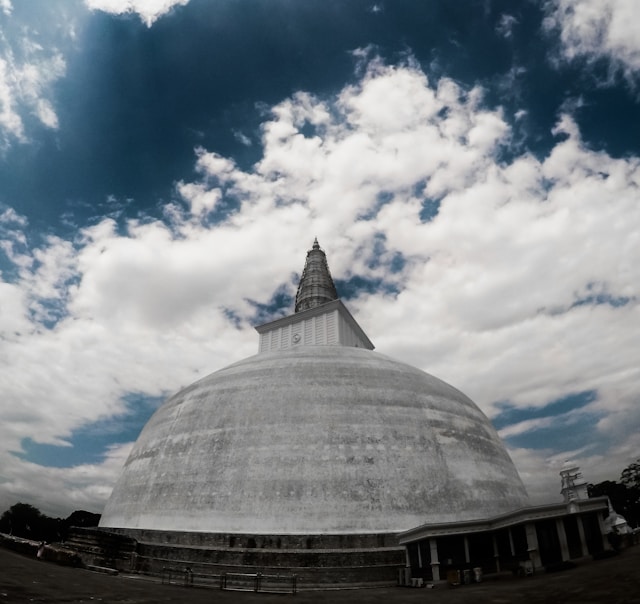Ancient Places
- Home
- Places to visit
Ancient Places of Sri Lanka
Anuradhapura Ancient City.

Anuradhapura Ancient City, located in the North Central Province of Sri Lanka, is a UNESCO World Heritage Site and one of the oldest continuously inhabited cities in the world. It served as the capital of Sri Lanka for over a millennium (from the 4th century BCE to the 11th century CE) and was the heart of Theravada Buddhism. Known for its grand stupas, ancient monasteries, and intricate reservoirs, Anuradhapura is a must-visit for history enthusiasts and cultural explorers.
Why Visit Anuradhapura?
The city offers a glimpse into Sri Lanka’s ancient civilization, showcasing remarkable engineering, architectural, and spiritual achievements. It’s a treasure trove of well-preserved ruins that reflect the country’s Buddhist heritage.
Places to Visit in Anuradhapura:
Ruwanwelisaya (Ruwanweli Maha Seya):
Built in the 2nd century BCE by King Dutugemunu, this massive stupa is one of the most sacred sites for Buddhists in Sri Lanka. It enshrines relics of the Buddha and symbolizes the king’s victory and unification of the country.
Sri Maha Bodhi (Sacred Bo Tree):
The oldest historically documented tree in the world, this sacred fig tree was grown from a sapling of the Bodhi Tree in India under which the Buddha attained enlightenment. It was planted in Anuradhapura in 288 BCE.
Jetavanarama Stupa:
Constructed in the 3rd century CE by King Mahasena, this stupa was the tallest brick structure in the ancient world, standing at 122 meters originally. It was part of the Jetavanarama monastery, a center for learning and meditation.
Abhayagiri Monastery:
A prominent monastery established in the 1st century BCE, it was a major center for Buddhist learning and attracted scholars from across Asia. The 75-meter-high Abhayagiri Stupa is the focal point of this site.
Thuparamaya Stupa:
The first stupa built in Sri Lanka by King Devanampiya Tissa in the 3rd century BCE, it is said to enshrine the Buddha’s right collarbone relic.
Isurumuniya Temple:
Dating back to the 3rd century BCE, this rock temple is famous for its intricate carvings, including the “Lovers of Isurumuniya” sculpture, which is considered a masterpiece of ancient art.
Kuttam Pokuna (Twin Ponds):
Built for the monks of Abhayagiri Monastery, these twin bathing ponds showcase advanced hydraulic engineering and elegant design.
Mihintale:
Located near Anuradhapura, Mihintale is the site where Buddhism was introduced to Sri Lanka by Arahat Mahinda in the 3rd century BCE. It is considered the cradle of Buddhism in the country.
Basawakkulama Tank (Abhaya Wewa):
One of the oldest irrigation tanks in Sri Lanka, constructed by King Pandukabhaya in the 4th
century BCE, it highlights the advanced water management systems of ancient Sri Lanka.
Samadhi Buddha Statue:
This 4th-century CE statue depicts the Buddha in deep meditation, reflecting serenity and spiritual depth. It is considered one of the finest examples of Sri Lankan sculpture.
Tips for Foreign Visitors:
Dress Modestly: As most sites are religious, wear attire that covers shoulders and knees.
Hire a Guide: A knowledgeable guide will enhance your visit by explaining the historical and cultural significance of each site.
Plan for a Full Day: Anuradhapura is vast, so allocate enough time to explore the key attractions.
Stay Hydrated: Carry water and sunscreen, as it can get quite hot during the day.
Respect the Culture: Be mindful of local customs, especially when visiting sacred sites.
Why Choose to visit Anuradhapura?
Anuradhapura Ancient City offers a journey through time, showcasing the grandeur of Sri Lanka’s ancient civilization. From awe-inspiring stupas to ingenious irrigation systems, it’s a destination where history, spirituality, and engineering marvels converge. For foreign visitors, it’s an unforgettable experience that highlights the richness of Sri Lanka’s heritage.
